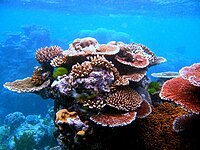
Photo from wikipedia
Coral reefs are a complex ecosystem consisting of coral animals and a vast array of associated symbionts including the dinoflagellate Symbiodinium, fungi, viruses and bacteria. Several studies have highlighted the… Click to show full abstract
Coral reefs are a complex ecosystem consisting of coral animals and a vast array of associated symbionts including the dinoflagellate Symbiodinium, fungi, viruses and bacteria. Several studies have highlighted the importance of coral-associated bacteria and their fundamental roles in fitness and survival of the host animal. The scleractinian coral Porites lutea is one of the dominant reef-builders in the Indo-West Pacific. Currently, very little is known about the composition and structure of bacterial communities across P. lutea reefs. The purpose of this study is twofold: to demonstrate the advantages of using PacBio circular consensus sequencing technology in microbial community studies and to investigate the diversity and structure of P. lutea-associated microbiome in the Indo-Pacific. This is the first metagenomic study of marine environmental samples that utilises the PacBio sequencing system to capture full-length 16S rRNA sequences. We observed geographically distinct coral-associated microbial profiles between samples from the Gulf of Thailand and Andaman Sea. Despite the geographical and environmental impacts on the coral-host interactions, we identified a conserved community of bacteria that were present consistently across diverse reef habitats. Finally, we demonstrated the superior performance of full-length 16S rRNA sequences in resolving taxonomic uncertainty of coral associates at the species level.
Journal Title: Scientific Reports
Year Published: 2017
Link to full text (if available)
Share on Social Media: Sign Up to like & get
recommendations!